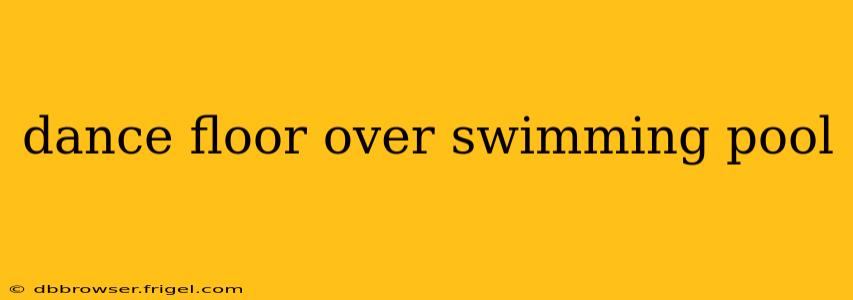Dreaming of a mesmerizing dance floor suspended above your sparkling swimming pool? This unique and luxurious feature can transform your backyard into an unforgettable entertainment space. However, creating a safe and functional dance floor over a pool requires careful planning, expert execution, and a deep understanding of structural integrity and safety regulations. This comprehensive guide will delve into every aspect, addressing common questions and concerns.
What are the Different Types of Dance Floors Suitable for Pool Installations?
Several options exist for building a dance floor above a pool, each with its own advantages and disadvantages. Common choices include:
-
Elevated Wooden Platforms: These offer a classic and relatively affordable solution. However, wood requires regular maintenance and sealing to withstand moisture and prevent rot. Careful consideration of weight capacity and structural support is crucial.
-
Steel or Aluminum Frame Structures: These provide robust support and can handle significant weight. The framing can be topped with a variety of dance floor surfaces, such as wood, composite decking, or specialized dance flooring. They tend to be more expensive but offer superior durability and longevity.
-
Custom-Designed Structures: For truly unique designs and specific requirements, a custom-built structure may be the best option. This involves working closely with structural engineers and builders to create a bespoke dance floor tailored to your space and aesthetic preferences.
How Much Does it Cost to Build a Dance Floor Over a Pool?
The cost of building a dance floor over a pool is highly variable and depends on several factors:
-
Size and complexity of the structure: A larger and more intricate design will naturally be more expensive.
-
Materials used: The choice of materials (wood, steel, composite) significantly impacts the overall cost. High-end materials and finishes will increase the price.
-
Labor costs: The complexity of the installation and the hourly rates of the professionals involved will play a substantial role.
-
Permits and inspections: Local building codes and permit requirements will add to the total cost.
Expect to invest a significant amount, ranging from several thousand dollars for smaller, simpler designs to tens of thousands for large, complex structures. Obtaining multiple quotes from reputable contractors is strongly recommended.
What Safety Precautions Should Be Taken When Building a Dance Floor Over a Pool?
Safety is paramount. Building a dance floor over a pool involves considerable risk, and neglecting safety precautions can lead to serious accidents. Essential considerations include:
-
Structural integrity: The structure must be designed and built by qualified professionals to ensure it can support the weight of people and withstand any potential loads. This includes considering wind loads, snow loads (depending on climate), and dynamic loads from dancing.
-
Non-slip surface: The chosen dance floor surface should be non-slip to prevent falls. This is critical given the proximity to a pool.
-
Handrails and barriers: Adding sturdy handrails or barriers around the perimeter of the dance floor can greatly enhance safety.
-
Regular inspections: Regular inspections of the structure are essential to identify and address any potential issues before they escalate.
-
Emergency access: Proper emergency access should be planned in case of accidents.
Is a Permit Required to Build a Dance Floor Over a Swimming Pool?
Almost certainly, yes. Building any structure, especially one as complex and potentially hazardous as a dance floor over a pool, typically requires permits from your local building department. These permits ensure the structure meets safety regulations and building codes. Failure to obtain the necessary permits could result in fines or even demolition. Check with your local authorities before commencing any construction.
What are the Potential Risks Associated With a Dance Floor Over a Pool?
While aesthetically stunning, a dance floor over a pool does present inherent risks:
-
Falls: The proximity of the pool makes falls a significant concern. Appropriate safety measures are crucial to mitigate this risk.
-
Structural failure: Poor construction or inadequate design can lead to structural failure, resulting in collapse and potential injury.
-
Water damage: Water damage to the structure can compromise its integrity over time. Regular maintenance and waterproofing are vital.
-
Electrical hazards: If any electrical components are involved, appropriate safety precautions must be taken to prevent electrical shocks or fires.
By carefully addressing these risks through diligent planning, professional construction, and regular maintenance, you can create a stunning and safe addition to your property. Remember to consult with qualified professionals throughout the entire process to minimize risks and ensure a successful project.
